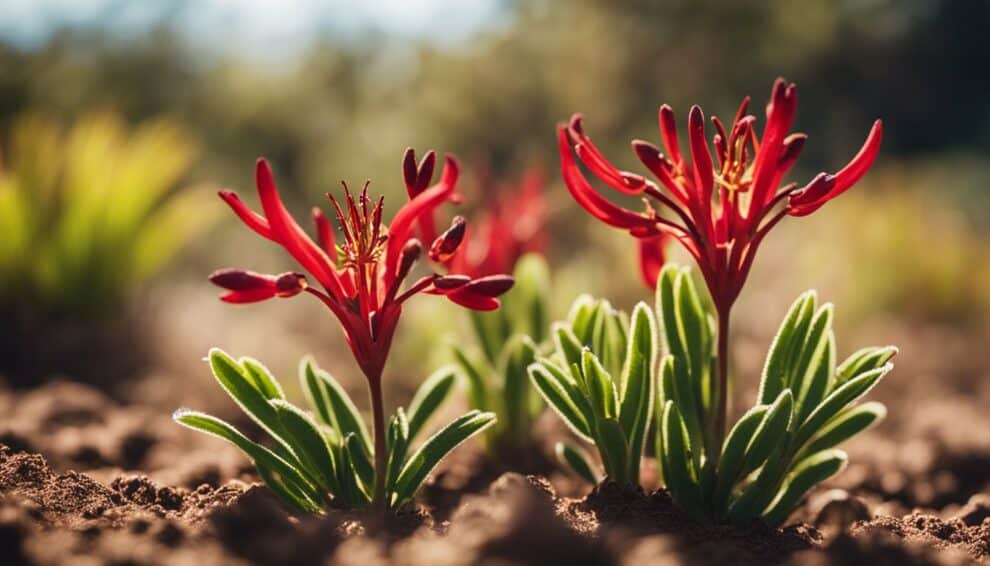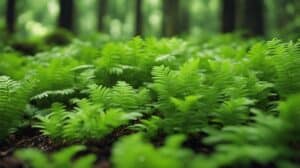Kangaroo Paw is a beautiful and unique plant that is native to Australia.
Its scientific name is Anigozanthos, and it is a member of the Haemodoraceae family.
This plant is known for its striking flowers that resemble kangaroo paws, hence its name.
The flowers come in a variety of colors, including red, pink, orange, yellow, and green, and they bloom in the spring and summer.

If you are a beginner gardener and looking to propagate Kangaroo Paws, then this guide is for you.
Propagation is the process of growing new plants from existing ones, and it can be done in several ways.
The most common methods of propagating Kangaroo Paws are through division, seed, or cuttings.
Each method has its advantages and disadvantages, and this guide will provide you with the information you need to choose the best method for your needs.
With the right care and attention, you can grow Kangaroo Paws in your garden or home and enjoy their beautiful flowers for years to come.
Understanding Kangaroo Paws

Species Overview
Kangaroo Paws, also known as Anigozanthos, are native to the southwestern part of Australia.
They are a part of the Haemodoraceae family and are perennial plants that grow from underground rhizomes.
The flowers of the Kangaroo Paw are unique and resemble a paw, which gives them their name.
They come in a variety of colors such as red, yellow, orange, and green, and can bloom for several months at a time.
There are several species of Kangaroo Paws, including Anigozanthos flavidus, Anigozanthos manglesii, and Anigozanthos pulcherrimus.
Each species has its own unique characteristics, but all require similar growing conditions.
Ideal Growing Conditions
Kangaroo Paws thrive in well-draining soil that is slightly acidic. They prefer full sun but can tolerate some shade.
It is important to provide them with regular water but avoid overwatering as this can cause root rot.
These plants are hardy and can withstand drought, but they do benefit from occasional fertilization.
A balanced fertilizer with equal amounts of nitrogen, phosphorus, and potassium is ideal.
Kangaroo Paws can be grown in containers or in the ground and are ideal for gardens, borders, and rockeries.
They are also a popular choice for cut flowers and can add a unique touch to floral arrangements.
In conclusion, understanding the basics of Kangaroo Paw propagation is essential for any beginner gardener.
By providing the right growing conditions and care, these unique and beautiful plants can thrive in any garden or home.
Propagation Basics

Propagation Timing
Kangaroo paws can be propagated from seeds or by division. The best time to propagate by division is in early spring, just as new growth begins to emerge.
This is also a good time to take cuttings. For seed propagation, the best time is in late winter or early spring.
Choosing Propagation Material
When propagating by division, choose a mature plant that has several stems or “fans”.
Dig up the plant and carefully separate the fans, making sure each one has roots attached.
When taking cuttings, choose a stem that is at least 6 inches long and has several leaves. Cut the stem just below a leaf node and remove the lower leaves.
Dip the cut end in rooting hormone and plant it in a well-draining potting mix.
It is important to choose healthy plant material for propagation.
Avoid plants that show signs of disease or stress, as these will not produce healthy offspring.
Additionally, make sure to use clean tools when dividing or taking cuttings to prevent the spread of disease.
Propagation Methods

Kangaroo Paw plants are commonly propagated through division, seed sowing, and tissue culture.
Each of these methods has its own advantages and disadvantages.
Division
Division is the most common method of propagating Kangaroo Paws. It involves dividing the plant into smaller sections, each with its own set of roots.
This method is best done in the spring or early summer when the plant is actively growing. To divide a Kangaroo Paw plant, follow these steps:
- Gently remove the plant from its pot or the ground.
- Use a sharp, sterilized knife to cut the plant into smaller sections, making sure each section has at least one healthy stem and a good set of roots.
- Replant each section in a new pot or in the ground, making sure to water it well.
Seed Sowing
Seed sowing is another method of propagating Kangaroo Paws. It is best done in the spring when the weather is warm.
To sow Kangaroo Paw seeds, follow these steps:
- Fill a seed tray with a good quality seed-raising mix.
- Scatter the seeds over the surface of the mix, making sure they are evenly spaced.
- Cover the seeds with a thin layer of the mix and water well.
- Place the tray in a warm, well-lit area, but out of direct sunlight.
- Keep the soil moist but not waterlogged.
- When the seedlings have grown to about 5cm tall, transplant them into individual pots or into the ground.
Tissue Culture
Tissue culture is a more advanced method of propagating Kangaroo Paws. It involves growing new plants from small pieces of the plant tissue in a laboratory.
This method is best done by experienced growers or professionals.
Tissue culture has the advantage of producing large numbers of identical plants in a short period of time.
However, it requires specialized equipment and expertise.
Aftercare and Troubleshooting
Post-Propagation Care
Once the kangaroo paw plants have been successfully propagated, it is important to provide them with proper care to ensure their growth and development.
Here are some tips to help with post-propagation care:
-
Watering: Kangaroo paws require regular watering, especially during the first few weeks after propagation.
Water the plants deeply once a week, and adjust the frequency based on the weather conditions and the soil moisture.
-
Fertilization: Fertilize the plants with a balanced, slow-release fertilizer once a month during the growing season (spring to fall).
Follow the instructions on the fertilizer package for the correct application rate.
-
Pruning: Remove any dead or damaged leaves or flowers to promote healthy growth.
Cut back the entire plant to about 6 inches in late winter or early spring to encourage new growth and flowering.
Common Issues and Solutions
Despite its hardiness, kangaroo paw plants can still encounter some issues during their growth. Here are some common problems and their solutions:
-
Yellowing leaves: If the leaves of the plant turn yellow, it may be a sign of overwatering, poor drainage, or nutrient deficiency.
To fix this, reduce the watering frequency, improve the soil drainage, or fertilize the plant with a high-nitrogen fertilizer.
-
Fungal diseases: Kangaroo paws are susceptible to fungal diseases, such as leaf spot and root rot.
To prevent these diseases, avoid overwatering, improve the soil drainage, and remove any infected plant parts. Apply a fungicide if necessary.
-
Pest infestations: Kangaroo paws may attract pests such as aphids, spider mites, and thrips.
To control these pests, spray the plants with a mild soap solution or an insecticide.
Avoid using harsh chemicals that may harm the plant or the environment.
By following these tips and troubleshooting solutions, beginners can successfully propagate and care for kangaroo paw plants.
Frequently Asked Questions

How can I successfully propagate kangaroo paw from cuttings?
Propagation of kangaroo paw from cuttings is possible and relatively easy. The best time to take cuttings is during spring or early summer.
Cut a stem that is about 10cm long and remove all the leaves except for the top two or three.
Dip the cut end in rooting hormone and plant it in a well-draining potting mix.
Keep the soil moist but not waterlogged and place the pot in a warm, bright spot. Roots should start to develop in about four to six weeks.
What are the ideal conditions for kangaroo paw seed germination?
Kangaroo paw seeds need a warm, bright and moist environment to germinate successfully.
Sow the seeds in a well-draining potting mix and cover them with a thin layer of soil.
Keep the soil moist but not waterlogged and place the pot in a warm, bright spot. Germination should occur within two to three weeks.
Are kangaroo paws suitable for indoor planting, and how do I care for them?
Kangaroo paws can be grown indoors, but they need a lot of light to thrive. Place the plant in a bright, sunny window or under grow lights.
Water the plant when the soil feels dry to the touch and fertilize it every two to three months during the growing season.
Prune back any dead or damaged leaves and flowers to promote new growth.
How often should kangaroo paw plants be watered during propagation?
During propagation, kangaroo paw plants should be watered when the soil feels dry to the touch.
Overwatering can cause the roots to rot, so it’s important to let the soil dry out slightly between waterings.
Once the plant is established, it should be watered once a week during the growing season and less frequently during the winter months.
Can kangaroo paw plants thrive in cooler climates, and how can I protect them?
Kangaroo paw plants are native to Australia and prefer warm, sunny climates.
They can be grown in cooler climates, but they may need extra protection during the winter months.
Cover the plant with a frost cloth or move it indoors if temperatures drop below freezing.
In areas with mild winters, kangaroo paw plants can be grown outdoors year-round.
What are the common pests to watch out for when propagating kangaroo paw?
Kangaroo paw plants are relatively pest-resistant, but they can be susceptible to spider mites and mealybugs.
Check the plant regularly for signs of infestation, such as webbing or white cottony spots, and treat with an insecticidal soap or neem oil if necessary.
Avoid overwatering, as this can create a humid environment that is conducive to pest infestations.













